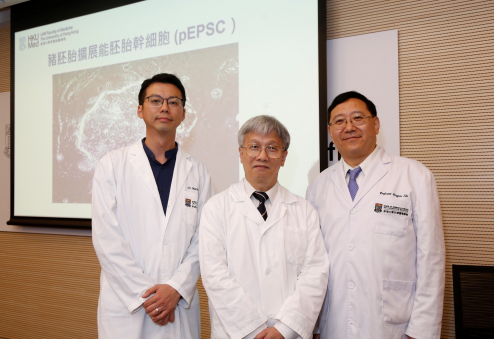研究故事
VP(R)'s Picks: A Breakthrough in Stem Cell Technology
上一頁
分享
相關連結
Embryonic stem cells generally are established from pre-implantation embryos made up of dozens of cells called blastocysts. But HKU scientists have managed to capture stem cells from embryos much earlier in the development process. Moreover, they have achieved this for multiple animal species such as mice, humans and pigs. The research opens up wide new avenues for science investigation, translational medicine and biotechnology.
Pioneering research by Professor Pengtao Liu has established a new way of deriving stem cells that is expected to have important bearing on the study of embryonic development and the development of translational research in genomic and regenerative medicine, biodiversity, and agriculture.
Professor Liu was the first to derive expanded potential stem cells (EPSCs) from mice in 2017 (Yang et al. Nature 2017) and recently extended that work to isolate EPSCs from humans and pigs. This is the first time anyone has derived embryonic stem cells from porcine (pig) pre-implantation embryos.
The first EPSCs were isolated from mouse embryos made up of only four to eight cells and thus at a very early developmental stage. This gives them totipotency features, meaning they have the potential to produce all types of cells – embryonic and extra-embryonic cells, including those in the placenta and yolk sac. By turning the development clock back to this earlier cell type, researchers will now be able to pursue new lines of scientific enquiry and translational medical research that are currently challenging.
The EPSCs from pigs are also significant because pigs are more similar to humans than mice in terms of anatomy and physiology (in particular organ size), which makes them increasingly important in biomedical research. Moreover, genetically modified pig stem cells could become beneficial for animal health and agriculture.
Professor Liu developed the human and pig EPSCs in collaboration with scientists from the Wellcome Sanger Institute in the UK and the Friedrich-Loeffler-Institut in Germany.

Related paper: Gao X., Nowak-Imiale M., Chen X., Chen D., Herrmann D., Ruan D., Chen A.C.H., Eckersley-Maslin M.A., Ahmad S., Lee Y.L., Kobayashi T., Ryan D., Zhong J., Zhu J., Wu J., Lan G., Petkov S., Yang J., Antunes L., Campos L.S., Fu B., Wang S., Yong Y., Wang X., Xue S.G., Ge L., Liu Z., Huang Y., Nie T., Li P., Wu D., Pei D., Zhang Y., Lu L., Yang F., Kimber S.J., Reik W., Zou X., Shang Z., Lai L., Surani A., Tam P.P.L., Ahmed A., Yeung W.S.B., Teichmann S.A., Niemann H. and Liu P., “Establishment of porcine and human expanded potential stem cells”, Nature Cell Biology, 2019, 21, 687-699.




